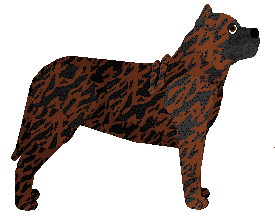


Brindle:




 with
with  striping.
striping.Masking: Must always be masked with
 (standard mask)
(standard mask)White Markings:
 allowed as trim on the chest, throat and/or toes, but it's not preferred.
allowed as trim on the chest, throat and/or toes, but it's not preferred.
Dogo Canario
Working
Coat







 with
with  striping.
striping. (standard mask)
(standard mask) allowed as trim on the chest, throat and/or toes, but it's not preferred.
allowed as trim on the chest, throat and/or toes, but it's not preferred.
Eyes

Nose

Faults
Disqualifications
Varieties
Notes
Breed Files


Filename: Dogo Canario
Offset: 0024
Base: Great Dane
SCP: Great Dane
Accepted: April 3, 2008
Notes: Addballz ears (can be hanging, rose or cropped) and tail (4 carriage variations). Optional shoulder wrinkles and 4 topline variations.